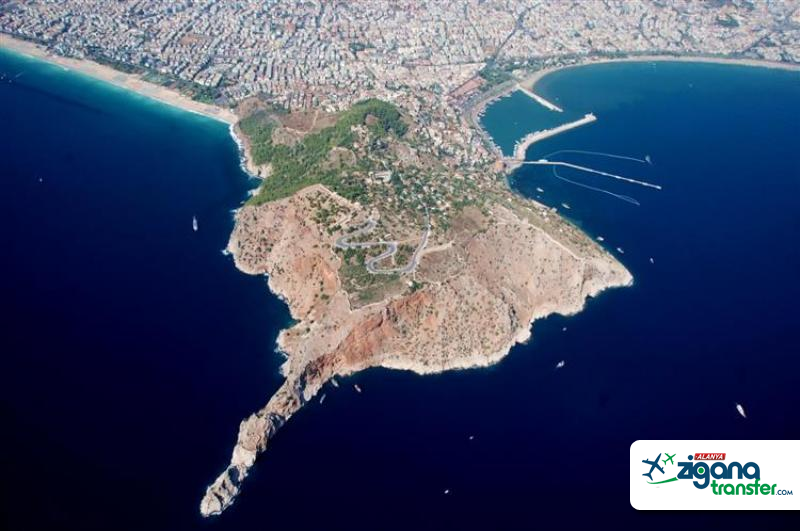Alanya Castle History

Alanya Castle, surrounded by 6 km long city walls and located on a 10 hectare peninsula; It hosted Hellenistic, Roman, Byzantine, Seljuk and Ottoman civilizations.
From Alanya, where the date of establishment and by whom it was founded is not known for certain, the first BC. Century geographer Scylax refers to Korakesion (Coracesium). Strabo; It defines Korakesion as the first visible city Cilicia is entered from the west and states that it was built on a very steep rock which is difficult to be captured.
The Korakesion; Thanks to its natural defense facility and sheltered harbor, even with a small military unit, it was an ideal refuge for pirates and rebels. II. It became a pirate port and center in the 19th century. The Hellenistic fortification wall with large block stones and mortar, located in the part of Orta Kale from Arab Evliya to Ehmedek. II. In the 16th century, the city's ruler was from the period of Diototos Tryphon.
Pirate domination ends with the Battle of Korakesion, which ended with the victory of Pompeius from Rome in 65 BC. The city grew by expanding the walls and adding new buildings during the Roman period. During this period, coins were minted on behalf of the emperors. Coins samples can be seen in Alanya Museum.
Alanya Castle; By the name of Kalonoros (beautiful mountain) during the Byzantine period, it became an important locating point for sailors and the busiest port of the Mediterranean. The church in İçkale, the Arabian awliya, the ruins of the monastery on the nose of Cilvarda, and the ruins of the walls with the round tower from Orta Hisar to İçkale belong to the Byzantine period.
Kalonoros in 1221; The castle is delivered to the Anatolian Seljuk Sultan Alaaddin Keykubat by Kyr Vart and its name is changed to Alaiye. I. Alaaddin Keykubat starts a major reconstruction activity, strengthens old walls, build new walls and gives Alanya its brightest period. The existing walls, big cisterns, Tersane, Kızılkule, Tophane, and the palace complex in İçkale are some of the works built by Alaaddin. Ehmedek, Akşebe Masjid, Andızlı Mosque, Seljuk bath and Asagi Kale bath were built during the Seljuk period.
With the acquisition of Alaiye, the Anatolian Seljuk State has a strong fortress on both the sea and land, as well as a strong fortress on the Mediterranean coast. Alaiye reaches a special position in developing domestic, foreign and transit trade.
Alaia; In the first half of the 14th century, Anatolia is among the important cities of Anatolia and the Mediterranean as a leading trade city of the Seljuks, an important naval base, a trade and shipbuilding center with strong relations with Egypt and Syria. In addition to the Egyptian traders who came for the famous cedar trees mostly used in shipbuilding; Genoese, Venice and Florentine traders were also buying spices, flax and sugar from Alanya. In his book "practura della mercatura", Pegolotti presents a scale comparing the weights and measurements used in Alanya with the Italian weights and measurements. Egyptian and Syrian traders were also traveling to the Black Sea ports via Alanya.
Alaia; With the collapse of the Seljuk state, it fell into the hands of the Kingdom of Cyprus for a short time (1293), and came under Ottoman rule after the periods of Karaman and Alaiye Beylik (1471).
The Süleymaniye Mosque, located in Yukari Kale, is between the Bedesten and the traditional Alanya Houses.
Alaia; It was renamed as Alanya at the request of Mustafa Kemal Atatürk, who visited the city during the Republican period.
Many local and foreign travelers talk about Alanya Castle. In 1332 Ibn Batuta stated that the timber was exported to Alexandria, Dimyat and other Egyptian cities; Towards 1650, Katip Çelebi compared the Alanya Castle with the Baghdad fortress in terms of grandeur, where cotton, silk and sesame were grown; In 1671, Evliya Çelebi had 300 houses, and the Sulaymaniyah Mosque and Akşebe Mosque, a cistern, houses without a courtyard, 2 madrasahs, 6 children's schools, 3 inns, 1 bath, 1 fountain and 150 shops. It states that it has a ladder and that transportation is provided with mules and donkeys.
Setton Llyod; In his book Alai, he divides Alanya Castle into 5 regions through the regions where the walls are partitioned. The first region is the crescent shaped with one end in Kızılkule and the other in Tersane; the second zone is the sloping portion of the hill above the first zone; the third region is the region where Ehmedek is located and extends to İçkale; the fourth region is İçkale; the fifth region is the region where Cilvarda nose is included.
